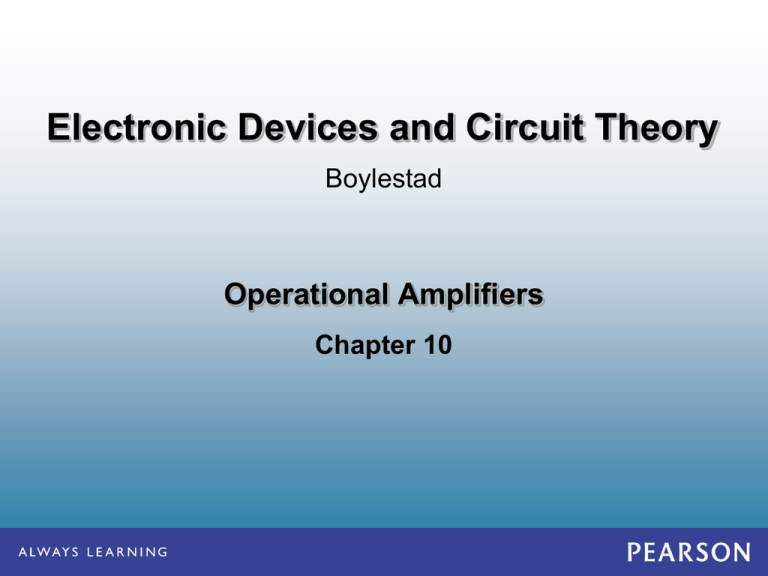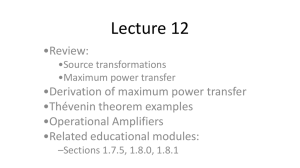
Electronic Devices and Circuit Theory
Boylestad
Operational Amplifiers
Chapter 10
Ch.10 Summary
The Basic Op-Amp
Operational amplifier (Op-amp): A high gain differential
amplifier with a high input impedance (typically in M) and
low output impedance (less than 100).
Note the op-amp has two inputs and one output.
Electronic Devices and Circuit Theory
Boylestad
© 2013 by Pearson Higher Education, Inc
Upper Saddle River, New Jersey 07458 • All Rights Reserved
Ch.10 Summary
Op-Amp Gain
Op-Amps can be connected in open-loop or closed-loop
configurations.
Open-loop: A configuration with no feedback from the op-amp output
back to its input. Op-amp open-loop gain typically exceeds 10,000.
Closed-loop: A configuration that has a negative feedback path from
the op-amp output back to its input. Negative feedback reduces the
gain and improves many characteristics of the op-amp.
• Closed-loop gain is always lower than open-loop gain.
Electronic Devices and Circuit Theory
Boylestad
© 2013 by Pearson Higher Education, Inc
Upper Saddle River, New Jersey 07458 • All Rights Reserved
Ch.10 Summary
Inverting Op-Amp
The input signal is applied to
the inverting (–) input
The non-inverting input (+)
is grounded
The feedback resistor (Rf)
is connected from the output
to the negative (inverting)
input; providing negative
feedback.
Electronic Devices and Circuit Theory
Boylestad
© 2013 by Pearson Higher Education, Inc
Upper Saddle River, New Jersey 07458 • All Rights Reserved
Ch.10 Summary
Inverting Op-Amp Gain
Gain is set using external resistors: Rf and R1
Av
Vo R f
V i R1
Gain can be set to any value
by manipulating the values of
Rf and R1.
Unity gain (Av = 1):
Rf R1
Av
Rf
1
R1
The negative sign denotes a 180 phase shift between input and output.
Electronic Devices and Circuit Theory
Boylestad
© 2013 by Pearson Higher Education, Inc
Upper Saddle River, New Jersey 07458 • All Rights Reserved
Ch.10 Summary
Virtual Ground
Virtual ground: A term used
to describe the condition
where Vi 0 V (at the inverting
input) when the noninverting
input is grounded.
The op-amp has such high input
impedance that even with a high
gain there is no current through
the inverting input pin, therefore
all of the input current passes
through Rf.
Electronic Devices and Circuit Theory
Boylestad
© 2013 by Pearson Higher Education, Inc
Upper Saddle River, New Jersey 07458 • All Rights Reserved
Ch.10 Summary
Common Op-Amp Circuits
Inverting amplifier
Noninverting amplifier
Unity follower
Summing amplifier
Integrator
Differentiator
Electronic Devices and Circuit Theory
Boylestad
© 2013 by Pearson Higher Education, Inc
Upper Saddle River, New Jersey 07458 • All Rights Reserved
Ch.10 Summary
Inverting/Noninverting Amplifiers
Inverting Amplifier
Vo
Rf
V1
R1
Electronic Devices and Circuit Theory
Boylestad
Noninverting Amplifier
Vo (1
Rf
)V1
R1
© 2013 by Pearson Higher Education, Inc
Upper Saddle River, New Jersey 07458 • All Rights Reserved
Ch.10 Summary
Unity Follower
Vo V1
Electronic Devices and Circuit Theory
Boylestad
© 2013 by Pearson Higher Education, Inc
Upper Saddle River, New Jersey 07458 • All Rights Reserved
Ch.10 Summary
Summing Amplifier
Because the op-amp
has a high input
impedance, the
multiple inputs are
treated as separate
inputs.
R
R
R
Vo f V1 f V2 f V3
R2
R3
R1
Electronic Devices and Circuit Theory
Boylestad
© 2013 by Pearson Higher Education, Inc
Upper Saddle River, New Jersey 07458 • All Rights Reserved
Ch.10 Summary
Integrator
The output is the
integral of the input;
i.e., proportional to the
area under the input
waveform. This circuit
is useful in low-pass
filter circuits and sensor
conditioning circuits.
1
v o (t )
v 1(t )dt
RC
Electronic Devices and Circuit Theory
Boylestad
© 2013 by Pearson Higher Education, Inc
Upper Saddle River, New Jersey 07458 • All Rights Reserved
Ch.10 Summary
Differentiator
The differentiator
takes the derivative
of the input. This
circuit is useful in
high-pass filter
circuits.
v o (t ) RC
dv1(t )
dt
Electronic Devices and Circuit Theory
Boylestad
© 2013 by Pearson Higher Education, Inc
Upper Saddle River, New Jersey 07458 • All Rights Reserved
Ch.10 Summary
DC-Offset Parameters
Even when the input voltage is zero, an op-amp can have an
output offset. The following can cause this offset:
Input offset voltage
Input offset current
Input offset voltage and input offset current
Input bias current
Electronic Devices and Circuit Theory
Boylestad
© 2013 by Pearson Higher Education, Inc
Upper Saddle River, New Jersey 07458 • All Rights Reserved
Ch.10 Summary
Input Offset Voltage (VIO)
The specification sheet for an op-amp indicates
an input offset voltage (VIO).
The effect of this input offset voltage on the
output can be calculated with
Vo(offset) VIO
Electronic Devices and Circuit Theory
Boylestad
R1 Rf
R1
© 2013 by Pearson Higher Education, Inc
Upper Saddle River, New Jersey 07458 • All Rights Reserved
Ch.10 Summary
Input Offset Current (IIO)
If there is a difference between the dc bias currents generated by
the same applied input, this also causes an output offset voltage:
The input offset current (IIO) is specified in the specifications for
an op-amp.
The effect of IIO on the output offset voltage can be calculated
using:
V o(offset ) Vo(offset due to VIO ) Vo(offset due to IIO )
Electronic Devices and Circuit Theory
Boylestad
© 2013 by Pearson Higher Education, Inc
Upper Saddle River, New Jersey 07458 • All Rights Reserved
Ch.10 Summary
Total Offset Due to VIO and IIO
Op-amps may have an output offset voltage due to VIO
and IIO. The total output offset voltage equals the sum of
the effects of both:
Vo (offset) Vo (offset due to VIO ) Vo (offset due to IIO )
Electronic Devices and Circuit Theory
Boylestad
© 2013 by Pearson Higher Education, Inc
Upper Saddle River, New Jersey 07458 • All Rights Reserved
Ch.10 Summary
Input Bias Current (IIB)
A parameter that is related to input offset current (IIO) is called
input bias current (IIB)
The input bias currents are calculated using:
IIB IIB
IIO
2
IIB IIB
IIO
2
The total input bias current is the average of the
two:
IIB IIB
IIB
2
Electronic Devices and Circuit Theory
Boylestad
© 2013 by Pearson Higher Education, Inc
Upper Saddle River, New Jersey 07458 • All Rights Reserved
Ch.10 Summary
Frequency Parameters
An op-amp is a wide-bandwidth amplifier. The
following factors affect the bandwidth of the opamp:
Gain
Slew rate
Electronic Devices and Circuit Theory
Boylestad
© 2013 by Pearson Higher Education, Inc
Upper Saddle River, New Jersey 07458 • All Rights Reserved
Ch.10 Summary
Gain and Bandwidth
The op-amp’s high
frequency response is
limited by its internal
circuitry. The plot shown
is for an open loop gain
(AOL or AVD). This means
that the op-amp is
operating at the highest
possible gain with no
feedback resistor.
In the open loop mode, an op-amp has a narrow bandwidth. The
bandwidth widens in closed-loop mode, but the gain is lower.
Electronic Devices and Circuit Theory
Boylestad
© 2013 by Pearson Higher Education, Inc
Upper Saddle River, New Jersey 07458 • All Rights Reserved
Ch.10 Summary
Slew Rate (SR)
Slew rate (SR): The maximum rate at which an
op-amp can change output without distortion.
ΔVo
SR
Δt
(in V/s)
The SR rating is listed in the specification sheets
as the V/s rating.
Electronic Devices and Circuit Theory
Boylestad
© 2013 by Pearson Higher Education, Inc
Upper Saddle River, New Jersey 07458 • All Rights Reserved
Ch.10 Summary
Maximum Signal Frequency
The slew rate determines the highest
frequency of the op-amp without distortion.
f
SR
2πVp
where VP is the peak voltage
Electronic Devices and Circuit Theory
Boylestad
© 2013 by Pearson Higher Education, Inc
Upper Saddle River, New Jersey 07458 • All Rights Reserved
Ch.10 Summary
General Op-Amp Specifications
Other op-amp ratings found on specification
sheets are:
Absolute Ratings
Electrical Characteristics
Performance
Electronic Devices and Circuit Theory
Boylestad
© 2013 by Pearson Higher Education, Inc
Upper Saddle River, New Jersey 07458 • All Rights Reserved
Ch.10 Summary
Absolute Ratings
These are
common
maximum ratings
for the op-amp.
Electronic Devices and Circuit Theory
Boylestad
© 2013 by Pearson Higher Education, Inc
Upper Saddle River, New Jersey 07458 • All Rights Reserved
Ch.10 Summary
Electrical Characteristics
Note: These ratings are for specific circuit conditions, and they often
include minimum, maximum and typical values.
Electronic Devices and Circuit Theory
Boylestad
© 2013 by Pearson Higher Education, Inc
Upper Saddle River, New Jersey 07458 • All Rights Reserved
Ch.10 Summary
CMRR
One rating that is unique to op-amps is CMRR or common-mode
rejection ratio.
Because the op-amp has two inputs that are opposite in phase
(inverting input and the non-inverting input) any signal that is
common to both inputs will be cancelled.
Op-amp CMRR is a measure of the ability to cancel out commonmode signals.
Electronic Devices and Circuit Theory
Boylestad
© 2013 by Pearson Higher Education, Inc
Upper Saddle River, New Jersey 07458 • All Rights Reserved
Ch.10 Summary
Op-Amp Performance
The specification sheets
will also include graphs
that indicate the
performance of the opamp over a wide range of
conditions.
Electronic Devices and Circuit Theory
Boylestad
© 2013 by Pearson Higher Education, Inc
Upper Saddle River, New Jersey 07458 • All Rights Reserved








